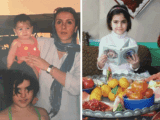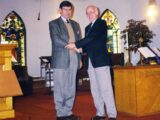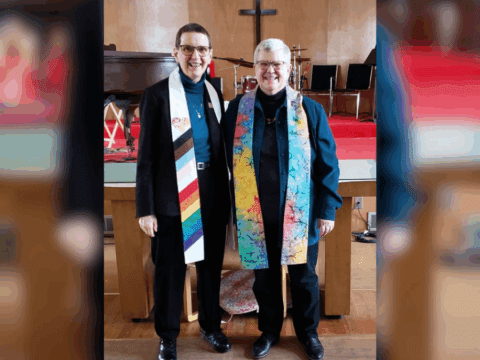First, a few words about my own roots in The United Church of Canada. My mother grew up in the early part of the 20th century in the Methodist Church, in a small rural congregation in the Annapolis Valley of Nova Scotia. My grandfather, the local doctor, helped build the church building, and my mother and my aunts had to go to it every Sunday and sit in the front row and provide models of decorum and good behaviour. This was sometimes challenging, as when a visiting minister started pounding the pulpit and so carried away did he become that his false teeth shot out of his mouth. Not for the first time, however, as he caught them neatly and inserted them back into his mouth, barely missing a phrase. The front pew shook. Luckily, said my mother, “We were at the front, so all they could see was our backs.”
My mother’s church was at the centre of her small community. Not only Sunday services and marriages and funerals took place in it, but society meetings of all kinds: groups for children, young peoples’ societies, ladies’ aid groups of one kind or another. During the First World War, my grandmother was a member of a knitting society, knitting items for the troops. You began with washcloths, then graduated to scarves, balaclavas and — if you were really good — to socks and mittens. My grandmother was a rotten knitter. She never got beyond the washcloths. But it’s the thought that counts.
You may unsubscribe from any of our newsletters at any time.
The Methodists then joined with some of the Presbyterians to form The United Church of Canada, which thus became, for a time, perhaps the most dominant denomination in Canada. Some years later, I myself, by this time in Toronto, frequented the United Church. I upset my by-then religiously unaffiliated parents when I stated that I wished to go to Sunday school. This was to satisfy my insatiable curiosity.
The church was St. Clair United, and I won the prize for the best essay on temperance in 1949, when I was nine. This essay described the horrors of drinking — having your nose turn red from expanded varicose veins, falling into snowbanks and freezing to death — and was luridly illustrated with pictures of bottled spirits, then freely available in colourful magazine advertisements. At that same time, I was attending Brownies at Deer Park United, which gave me a useful knowledge of ropes and knots.
Somewhat later, I found myself at Victoria College at the University of Toronto — again, a United Church establishment — studying English literature from the Anglo-Saxons to T.S. Eliot, something it was impossible to do without a grounding in biblical knowledge and in theology. Those were the years when Northrop Frye, author of, among other things, Fearful Symmetry: A Study of William Blake, was giving his famous Bible course, which was not only taken by a lot of students but audited by a great many more. It was a course that dealt with the Bible as literature and was enormously famous at that time and very useful.
All of which — that is to say, except the temperance varicose veins part — came in very handy when I set out to write The Year of the Flood.
The God’s Gardeners in that book are attempting to combine religious belief with scientific knowledge and a reverence for nature — something that on the face of it — and especially if one insists that the Bible must be taken liter- ally, word by word — would seem impossible to do. But is it really so impossible? There are signs that at least some among Christians are taking a turn in that direction, as witnessed by the recent publication of the Green Bible, which is printed on ecologically friendly paper, has the “green” parts printed in green, has an introduction by Archbishop Tutu, has a number of green suggestions for you to do at the back, and has covers made of linen. They thought of everything.
In fact, when one looks back in time, one realizes it is only very recently that religion — specifically the Christian religion — came unglued from nature and turned away from it. Many other religions never broke that bond. In the Qur’an, animals are to be respected and are credited with having societies equal to ours. Buddhists and Hindus, the Shinto of Japan and the Parsis of India all maintain quite strong links to the old ties. What happened in the West?
Let’s go even further back in time and look at some ancient ways of life and some ancient gods. Human beings spent at least 50,000 years as hunter-gatherers in the Pleistocene Era before the advent of pastoralism and then agriculture, more or less 4,000 years ago. Literacy — reading and writing — and urbanization are even more recent. The Industrial Revolution is a couple of hundred years old. Coal furnaces, oil and electricity, and then computer technology, all became widely deployed only within living memory.
What did these successive ages and stages have to do with faith and the objects of it? The Pleistocene is a long way back, and we have no direct information about what people worshipped then. But we do have indirect evidence: grave burials, and the items found in them, indicate that some people, at least, believed in an afterlife. The magnificent paintings in the caves of Chauvet and Lascaux not only tell us what animals were present in southern Europe then, but tell also of their supreme importance to those peoples. Human figures are small and scarce in these paintings: power and strength belong to the animals. Some of the human figures look semi-animal and may be shamans dressed in animal skins and antlers — the better to enter a trance state and communicate with the animal spirits in order to ask them, or the gods that protected them, for their support and help.
Present day Shamanism, such as has survived, may give some clues. Animals, as well as people, and indeed plants and stones, were all thought to have spirits. Unless the spirit of a prey animal was honoured, the spirit of the animal killed for food would be angry, and the animals would refuse to give themselves in this way again. Hunting was not a case of man dominating and imposing his will on the animals: instead, their co-operation was sought and their sacrifice rewarded. In those societies, you gave thanks directly to the animal that you had killed. A little later on, people gave thanks to God for providing the food. That survives in the form of grace. But a lot of people now don’t give thanks to anything. They think that food comes from the supermarket, and I doubt that you’re going to bow your head and say, “Thank you very much, Loblaws.” Maybe you do. I’ve never seen it.
So when did we stop realizing that we’re part of an interdependent whole and that food just doesn’t come out of plastic packages? Because a lot of kids now do grow up believing that that’s where it comes from.
With the advent of agriculture and the domestication of animals, the situation changed somewhat. Different animals become sacred, more likely to be bulls than bears. The dying and rising god becomes important, in Sumer with Dumuzi the shepherd, then as Tammuz, as Osiris in Egypt, and as Persephone among the Greeks. In all, the god is planted like a seed in the ground and then springs forth from this burial renewed. Weather gods appeared, associated with mountains, for it was from mountains that the life-giving rivers flowed, fed by the rain clouds gathered at the mountaintops. Weather cycles and dependable rains determined crop success and the fertility of the land. Zeus and his thunderbolts and his seat on top of Mount Olympus is one example, as is Thor the Thunderer — originally, not just a comic-book superhero. There is some evidence that Jehovah himself had weather-god, mountain-god origins.
Thus Moses goes up the mountain for communications purposes, and the promise made to Noah is an assurance about weather: no more big floods, and seedtime and harvest in their appointed rounds. (Incidentally, climate change of the annihilating flood kind is linked to bad human behaviour in that story. Just saying.)
Also just saying that the Covenant after the flood was made not only with man but with the animals — “with all flesh,” a phrase repeated several times to make sure we get it. You can’t make a covenant with a lifeless object. God spoke directly to the animals, which means they have beings and souls in that story. And the passage usually interpreted as Dominionism — man rules and can do whatever he likes to animals — can also be read as a warning to the animals: man’s imagination is evil unto his youth, and he will behave that way and grab all you’ve got. So run away very fast.
By recorded times — no doubt as a continuation of unrecorded times — we already see holy days and holy places, consecrated foods, daily foods, feast-time foods and forbidden foods. What you eat, how you worship, what kind of culture you live in and what supplies it needs to sustain itself are all linked. But all early religions acknowledged the bond between man and nature. They understood that what sustains us comes from the earth. All of it.
Fast forward to medieval times, when Christian cosmology was mirrored by the interior decoration of cathedrals: the heavens above with stars, God and angels; Creation at one end of the story replete with garden beginnings and communication with animals, as well as with God; then the story unfolding around the walls with resurrection and revelation at the end; pillars oddly like tree trunks holding it all up; on the stone and wood and stained glass decorations, a veritable jungle of plants and fruit and flowers and birds and animals; sometimes a “Green Man” — that mysterious figure speaking for vegetation (probably a wood spirit or a plant spirit). All was included — the whole Creation and all of history contained as if in a glass snow globe of the known universe. Man and nature together under God, who was on the ceiling or sometimes at the top of the stained glass window.
But then the top blew off. The advent of the telescope revealed a universe much bigger than was supposed. The planets were not shining crystalline globes. Saturn had moons. The moon had mountains and valleys. The Earth went ’round the sun and was not at the centre of the solar system, much less of the universe.
Then Newtonian physics made the whole thing look like a mechanism, and the invention of clocks provided a metaphor for this view: the universe as a vast clock set going by a master tree; Blake looked at a tree and saw a tree full of angels praising God.
A slightly later rebellion came from the Romantics, who held that nature is sentient. That is, it’s conscious, does have emotions and is responsive. One of William Wordsworth’s lines is, “It is my faith that every flower enjoys the air it breathes.”
The scientists at that time dismissed these people as — I won’t say “raving loonies” — I’ll say “sissy poets.”
Then along came another scientific discovery that again altered the world view, and that was the discovery of electricity, which gave birth to another whole spate of metaphors. That’s where we get our expression “frayed nerves.” In this model, you were basically an electrical system — which in some ways is true — but they thought your nerves were like electric wires. When you were having an emotional crisis, it was because those electrical wires were frayed, just like real ones, and you needed to be rewired.
But this model gave rise to another possible world view: that we were all connected through invisible electrical or etheric vibrations of some kind. The upsurge of spiritualism is connected with this, and so was the invention of a whole watchmaker, who was not overseeing everything and intervening with miracles, but was strangely elsewhere. Nature, too, was a machine and animals were machines who did not feel pain or have emotions. How strange that this was believed, but also how convenient! Man alone had a soul and/or a mind, the famous ghost in the machine — the machine being another clock, his body. It is at this time that animals came to be thought of as dumb and stupid, without feeling, without language, mere machines who obeyed only their mechanical settings. Earlier societies would never have made this mistake. People who worked with animals did not make it. But it was a widely accepted so-called scientific credo.
William Blake rebelled against this view. He proposed nature as divine, and he wrote a well- known rebellion against Newton:
The Atoms of Democritus
And Newton’s Particles of light
Are sands upon the Red Sea shore, Where Israel’s tents do shine so bright.
Other people might look at a tree and see a bunch of electric machines that you could rejuvenate yourself with in one way or another. You could wear voltaic belts, for instance, and you could buy machines you could plug yourself into. I don’t know how many people got electrocuted in the process. The underlying belief was that you could recharge yourself like a battery. Do not try this at home.
Then along came Darwin, who gave rise to yet another world view. In his famous theory of evolution, man is akin to the animals — a lot more closely akin than people found comfortable. Strangely enough, Darwin himself proposed that animals have emotions. But the Darwinists who picked up from some of his theories ignored this, especially because the scientists wanted to do experiments on animals. They were still adhering to the “animals don’t really feel” view of life: it was convenient. And social Darwinists like Hitler misappropriated Darwin to horrific effect.
You’ll be unhappy to know that the people in the late 20th century who came back to the view that animals have emotions and languages were at first dismissed by the orthodox scientific community as being, again, soft romantics and raving loonies. But the scientific establishment is now coming around, especially with the work of people like Frans de Waal and his book The Age of Empathy. His work contradicts the previous orthodoxy, which held that we’re all inherently selfish and aggressive. The Age of Empathy is based on studies he has done with certain animals such as elephants and chimpanzees that uphold what we would like to believe: that true altruism is possible; that you can, in fact, help people without having some selfish motive underneath. Chimpanzees will do that. Elephants are very social and interactive. This is an encouraging counterthrust to the previous hard-core social Darwinist views.
Now, even in western thought and religion, we seem to be moving towards a more holistic view of the world — a view in which man and nature are connected once more. In Christianity, there are two views about this. One is the stewardship model, which I’m happy to see that you embrace: people should try to save the Earth because it is a divine creation and, not incidentally, because if we don’t the results will be horrific misery and ultimate extinction, not for nature but for us.
The second view is held by those who feel that the Earth doesn’t matter because God will destroy it and make another just for them. And those people — I guess you might call them “the Rapturists” — get points off for being so selfish. What would Jesus say about, “It would be fun to watch others fry”? What do you think about that?
The Gardeners in The Year of the Flood are extreme “stewardship” folk. They use all recycled materials, which they glean from trash bins. They live in a future society in which corporations and government have become one, thus forming a very top-heavy power structure (I hate to be predictive) and leaving the poorer elements of society to shift for themselves in the lawless plebelands. That is where the Gardeners choose to have their rooftop gardens: they gar- den on rooftops in slums. They grow all of their own food on these rooftop gardens. They are also creationists, though they do not have the same timeline as literalists, and they believe they have a responsibility to the Creation. They are vegetarian unless you get really, really hungry. And if you do get really, really hungry you have to start at the bottom of the animal food chain.
I won’t go into what that entails, but we may all be driven to it. Let us hope not.
They also take a very inclusive view of the Creation. We’ve heard a lot about fruits and flowers, and you know, trees, birds and nice things. The Gardeners feel they have to include everything, even the mosquitoes. They take into account everything that lives under the earth, as well as the things that live on top of it. And they include predators. So they are akin to Blake, in that they ask the question, “Did He that make the lamb make thee?” Their answer is a resounding yes. They have their own feast days; they have their own saints: Saint Farley Mowat, for instance, and Saint Robert Burns, the Saint of Interspecies Communication for the Mice. Some of their saints you might expect, such as Saint Francis, and some you may not expect because they are from other cultures.
But there is another character in the book who inclines more towards the destructionist model. His name is Crake. His idea is: destroy the imperfect version of ourselves that we now are — we human beings — and make a better version: people who will never make our mistakes because they have different instincts and capabilities. In real life, we have the tools to do this right now. We are already speeding along the track of genetic modification, and we can already make new microbes and alter viruses. I am not the only one to see this as not only a possibility, but a threat.
I shall conclude with a quote from Trevor Herriot, writing in his book River in a Dry Land, about man and nature on the Canadian Prairies. He says:
For the farmers of my grandfather’s generation, there was no strongbox that could resist the powers that have homogenized and industrialized prairie farms and landscapes. If there ever was such a container, it was the long-abandoned ark of our covenant with the land. A religious bond is needed, always has been, whether the people are hunter-gatherers or potato farmers, Shinto or Christian: a bond maintained by exact ethical guidelines telling how the Creation is to be used and honoured, which tools and practices sustain land and community, and when to restrict our reach and interdependencies.
To that, we can only say: Amen.
***
This story first appeared in The United Church Observer’s January 2012 issue with the title “Back to the Garden.”
This article is adapted from the 2011 Craddock Lecture, delivered by Margaret Atwood at Bloor Street United Church in 2011. You can see part one here: https://www.youtube.com/watch?v=bqz13Xy10Ow; part two here: https://www.youtube.com/watch?v=0wIFcWrZM4Y, and part three here: https://www.youtube.com/watch?v=Mym2pWUxqFM
















Just reading this for the first time. Authentic Christian teaching does not unglue God from nature. Authentic Christian teaching firmly states the glory of Gods presence can be apprehended in the creation. We call that General Revelation. The challenge lies when people worship creation and not the Creator. Nature is impersonal. It does not love or hate you. Our understanding of who God is more fully revealed in Christ. Any person who is not aware of Christian teaching would be teaching an incomplete doctrine of how God reveals God’s self in history to the human being.